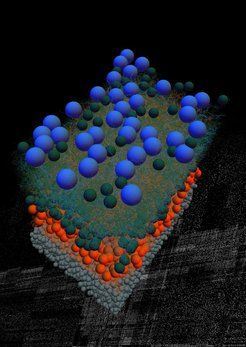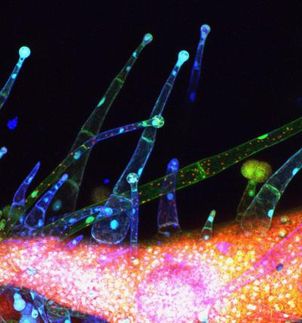Scientists discover new option to provide bananas with resistance to dreaded Black Sigatoka disease
Scientists from the Plant Sciences Group of Wageningen UR have found a new method for making banana plants resistant to the much feared Black Sigatoka disease. They recently showed that several proteins of very different types of fungi can be recognized by receptor-like proteins from different plant species that subsequently provide resistance against the harmful fungi. In the journal PNAS, the scientists describe how the same principle applies to pathogenic fungi of tomato and banana plants and the resistance these plants develop against the fungi that attack them. This opens up the possibility that the resistance genes of tomato plants active against tomato diseases could also be used in bananas to protect them against the devastating Black Sigatoka fungus.
Cladosporium fulvum, which causes leaf mould of tomatoes, produces proteins that can be recognized by resistant tomato plants. The first plant cells that detect the fungus quickly die in order to prevent further growth of the fungus. A distantly related fungal species, Mycosphaerella fijiensis, which causes the dreaded Black Sigatoka disease in banana plants, was shown to produce proteins of which certain domains are very similar to those of present in proteins produced by the tomato fungus.
The research was the result of joint efforts by Pierre de Wit, Professor of Phytopathology at Wageningen University, and Gert Kema, senior scientist at Plant Research International.” We showed that the proteins of Mycosphaerella fijiensis also provide a defence reaction in tomato plants resistant against Cladosporium fulvum,” says Ioannis Stergiopoulos, post-doc in De Wit’s research group, and first author of the article. “If we could transfer the genetic code for that resistance to the banana, we may be able to develop resistant banana plants.”
The research findings are of great importance to the International Pesticide Reduction Programme coordinated by Plant Research International. Kema: “Only one banana variety is cultivated worldwide, and that variety is extremely susceptible to disease. As a result banana plantations use over fifty applications of fungicides per year. Resistant banana plants could therefore lead to considerable environmental savings.”
The resistant banana plants would also provide an excellent solution for small farmers who do not have the money for chemical pesticides, as they would have the chance to harvest considerably more bananas. It would also be of major importance to these farmers and the people who live locally, because they are among those who rely most on the banana as a source of nutrition.
Most read news
Topics
Organizations
Other news from the department science

Get the life science industry in your inbox
By submitting this form you agree that LUMITOS AG will send you the newsletter(s) selected above by email. Your data will not be passed on to third parties. Your data will be stored and processed in accordance with our data protection regulations. LUMITOS may contact you by email for the purpose of advertising or market and opinion surveys. You can revoke your consent at any time without giving reasons to LUMITOS AG, Ernst-Augustin-Str. 2, 12489 Berlin, Germany or by e-mail at revoke@lumitos.com with effect for the future. In addition, each email contains a link to unsubscribe from the corresponding newsletter.
Most read news
More news from our other portals
Last viewed contents
BUSM study reveals novel mechanism by which UVA contributes to photoaging of skin

Protein ZAP inhibits multiplication of SARS-CoV-2 by 20-fold - Silver linings in the pandemic



















































